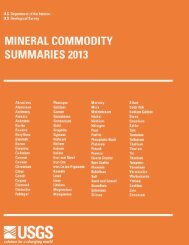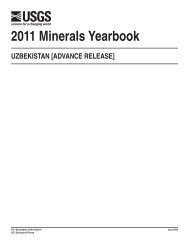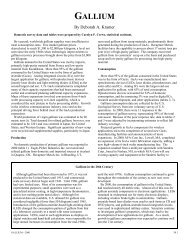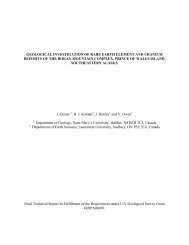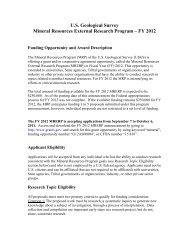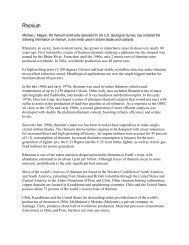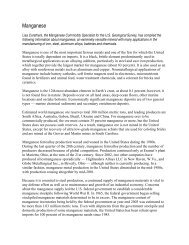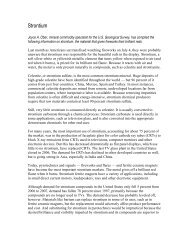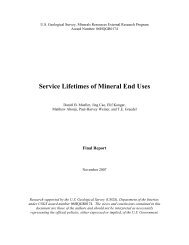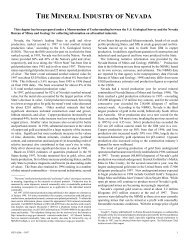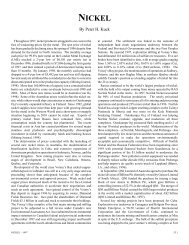Mineral Commodity Summaries 2003 - Mineral Resources Program ...
Mineral Commodity Summaries 2003 - Mineral Resources Program ...
Mineral Commodity Summaries 2003 - Mineral Resources Program ...
Create successful ePaper yourself
Turn your PDF publications into a flip-book with our unique Google optimized e-Paper software.
128<br />
POTASH<br />
(Data in thousand metric tons of K 2O equivalent, unless otherwise noted)<br />
Domestic Production and Use: In 2002, the value of production of marketable potash, f.o.b. mine, was about $280<br />
million; sales decreased relative to 2001. Prices declined for New Mexico producers in the first half of the year, but<br />
demand increased in the second half due to smaller crop harvests, which led to small price increases. Domestic<br />
potash was produced from Michigan, New Mexico, and Utah. Most of the production was from southeastern New<br />
Mexico, where two companies operated three mines. New Mexico sylvinite and langbeinite ores were beneficiated by<br />
flotation, heavy media separation, dissolution-recrystallization, or combinations of these processes, and provided more<br />
than 70% of U.S. producer total sales.<br />
In Utah, which has three potash operations, one company extracted underground potash by solution mining. The<br />
potash was recovered from brine solution by solar evaporation, and a standard flotation process separated the<br />
resulting potash crystals from sodium chloride crystals. Another Utah company collected subsurface brines from an<br />
interior basin for solar evaporation and standard flotation. The third Utah company collected lake brines for solar<br />
evaporation to form crystals, followed by flotation, and dissolution-recrystallization. In Michigan, a company used deep<br />
well solution mining and mechanical evaporation for crystallization of potash and byproduct sodium chloride.<br />
The fertilizer industry used about 80% of U.S. potash sales, and the chemical industry used the remainder. More than<br />
60% of the potash was produced as potassium chloride (muriate of potash). Potassium sulfate (sulfate of potash) and<br />
potassium magnesium sulfate (sulfate of potash-magnesia), required by certain crops and soils, were also sold.<br />
Salient Statistics—United States: 1998 1999 2000 2001 2002 e<br />
Production, marketable 1<br />
1,300 1,200 1,300 1,200 1,200<br />
Imports for consumption 4,780 4,470 4,600 4,500 4,700<br />
Exports 477 459 367 410 400<br />
Consumption, apparent 2<br />
5,600 5,100 5,600 5,400 5,600<br />
Price, dollars per metric ton of K2O, average, muriate, f.o.b. mine 3<br />
Employment, number:<br />
145 145 155 155 155<br />
Mine 730 660 610 585 540<br />
Mill<br />
Net import reliance<br />
780 725 665 670 645<br />
4 5 as a percentage of<br />
apparent consumption 80 80 80 80 80<br />
Recycling: None.<br />
Import Sources (1998-2001): Canada, 92%; Russia, 4%; Belarus, 2%; Germany, 1%; and other, 1%.<br />
Tariff: Item Number Normal Trade Relations<br />
12/31/02<br />
Crude salts, sylvinite, etc. 3104.10.0000 Free.<br />
Potassium chloride 3104.20.0000 Free.<br />
Potassium sulfate 3104.30.0000 Free.<br />
Potassium nitrate 2834.21.0000 Free.<br />
Potassium-sodium nitrate mixtures 3105.90.0010 Free.<br />
Depletion Allowance: 14% (Domestic and foreign).<br />
Government Stockpile: None.<br />
Events, Trends, and Issues: The world’s largest potash producers operated at reduced capacity for another year<br />
owing to potential oversupply. Again, this was accomplished through extended summer vacations and turnarounds at<br />
the mines and mills of Canada and the former Soviet Union. The Canadian potash industry operated for the first half<br />
of the year at above 70% of capacity, which was a increase from the first half of 2001; one company operated at about<br />
65% of capacity. At the end of 2001, North American producer stocks were slightly less than 2 million tons and potash<br />
prices declined slightly. By the end of August 2002, North American potash stocks were down to about 1.6 million tons<br />
and potash prices were firming. On the consumption side, southern hemisphere and Asian-Pacific region potash<br />
purchases rose in the first half of 2002 and into the third quarter owing to rising world grain prices. Belarus, Germany,<br />
and Russia faced nearly unchanged potash demand in their home markets, but were important exporters to Asian-<br />
Pacific farmers. Many other potash producers around the world operated at normal capacity. Grain prices and some<br />
other crop prices rose on the world market, which increased the demand for potash in grain-producing countries.<br />
Prepared by James P. Searls [(703) 648-7724, jsearls@usgs.gov, fax: (703) 648-7722]



